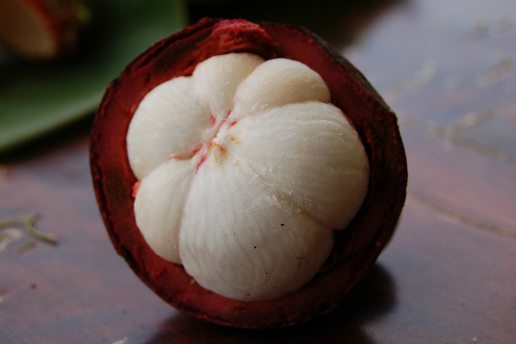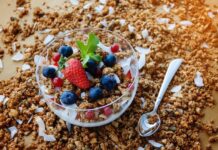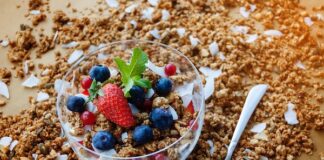At first glance, a mangosteen looks like a strange cross between an plum and an eggplant. With it’s thick, hard outer shell, it feels more like something you’d use if you were trying to break someone’s window than something you would eat. But didn’t your mother teach you never to judge a book by its cover (or a fruit by its shell in this case)? Well, if she didn’t, now’s the time to apply that lesson to this unique tropical delight. Cracking a mangosteen open reveals a delicate, white, juicy flesh that smells like a vacation in Thailand. Take a bite and you may actually convince yourself for a moment that you’re on a remote island somewhere.
As if these purple beauties weren’t already wonderful enough, they’re also good for you! A 100 gram serving of the fruit only has 63 calories, and contains significant amounts of fiber, folates, vitamin C, thiamin, copper, and manganese, as well as a number of phytonutrients which have been found to have antioxidant and cancer-fighting properties. A connection has also recently been made linking mangosteen juice and reduced levels of C-reactive proteins (CRPs), which are the inflammation-causing agents in diseases like rheumatoid arthritis and lupus.
The one drawback: they’re pretty pricey. Since they only grow in the tropical regions of Southeast Asia and some select areas of South America, they have to be imported into the US. It doesn’t help that they also have a very short peak growing season, and are only available for 6-10 weeks at a time. In the states, they can be found in Asian supermarkets as well as some specialty foods stores. If you can find them, we definitely urge you to give them a try!
The delicious fruits are usually enjoyed as is, but here are 5 great recipes that feature them:
- Make this light and refreshing mangosteen and lime sorbet
- Bake them in this mangosteen clafoutis
- Try this tropical sauce on bread or in yogurt
- Serve this exotic mangosteen cocktail at your next summer BBQ
- Combine it with other unique flavors in this mangosteen, avocado and yogurt parfait
Have you ever tried a mangosteen before?











![Daily Bite [Make]: Philly Cheesesteak Stuffed Bell Peppers](https://dashofwellness.com/wp-content/uploads/2013/01/Philly-Cheesesteak-Stuffed-Pepper-Daily-Bite-1-100x70.png)

I don’t think I”ve had these before. They are pretty though!